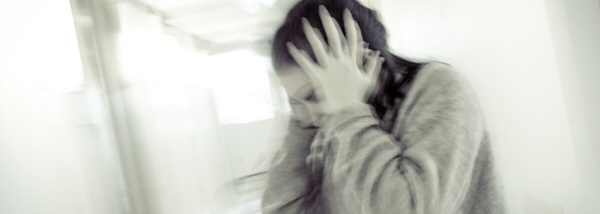- What is Cognitive Behavioral Therapy (CBT)?
- Internet treatment step by step
- Depression
- Body dysmorphic disorder (BDD)
- Health anxiety
- Irritable Bowel Syndrome (IBS)
- Panic disorder
- Social anxiety disorder
- Sleeping problems (insomnia)
- Obsessive-compulsive disorder (OCD)
- Olfactory reference syndrome (ORS) - study
- Generalized anxiety disorder (GAD, the ORIGAMI-study)
- Behandling
- Current page: Panic disorder
What is panic disorder?
Please note that the Internet-based treatment described on this website is conducted in Swedish and only available to people registered and living in Sweden.

Are you affected by sudden, strong physical reactions such as heart palpitations, dizziness and sweating? Do you feel frightened, think you are about to die or go crazy?
If this occurs time after time and leads to negative consequences it may be a sign of panic disorder, a common anxiety disorder.
How it feels
A panic attack occurs suddenly and is an experience of overwhelming fear. You are affected by a number of physical symptoms that signal an ongoing catastrophe. It often feels as if you're going to die, go mad or lose control. The symptoms reach their peak within 10 minutes and then reduce in intensity. In order for it to be called a panic attack 4 of the following 13 symptoms need to be present:
- Heart palpitations
- Sweating
- Trembling and shaking
- Breathing difficulties
- Feelings of choking
- Chest pain or discomfort
- Nausea or upset stomach
- Dizziness, unsteadiness or feeling faint
- Feeling unreal or detached from your surroundings
- Fear of losing control or going crazy
- Fear of dying
- Numbness or a tingling sensation
- Chills or hot flashes
Typical symptoms
In order to be diagnosed with panic disorder the panic attacks have to be repeated. In addition, at least one of the following has to occur:
- You worry a lot about having another panic attack.
- You are afraid that the panic attacks are going to lead to negative consequences (for example getting a heart attack or going crazy).
- You change your behaviour due to the attacks (for example avoiding situations where you are afraid of having a panic attack).
Consequences
Anticipatory anxiety means you have a constant fear of new attacks. This can in time be just as disabling as the panic attacks themselves. It is common to become excessively focused on your own body and different symptoms that you believe to be a sign of an oncoming panic attack. Agoraphobia often develops as a complication of panic attacks. It is a fear of places and situations that are difficult to get out of if you have a panic attack. These situations are therefore usually avoided. More than half of those who suffer from panic disorder have agoraphobia.
Occurrence
Studies show that as many as a third of the population has had a panic attack at some time. But if it only happens once, it does not classify as panic disorder. Panic disorder affects a few percentage of the population, several hundred thousand people in Sweden!
Treatment
If you suspect that you have panic disorder, we recommend that you seek health care where you live.
Please notice
The Internet-based treatment described on this website is conducted in Swedish and only available to people registered and living in Sweden.